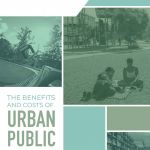Creative Communities
Public Space Evaluation
Public spaces are critical to life in cities. The COVID-19 pandemic underscores the importance of parks, trails, and sidewalks for physical, mental, and emotional health and well-being during stay-at-home and safer-at-home orders (Samuelsson, Barthel, Colding, Macassa, & Giusti, 2020). Limited ability to travel has shifted mobility patterns and increased need for local, accessible, and safe public spaces in every urban neighborhood. There is an increased urgency in the need to understand if our public spaces are adequately serving all communities across cities. Inequities in urban public spaces have far-reaching impacts because public spaces offer many benefits to neighborhoods by providing opportunities for social connections, lowering temperatures, creating spaces for physical activity, offering health-related information, and serving as refuge sites during extreme weather events.
In this report, we synthesize literature on how public spaces are evaluated to understand if our frameworks and methods allow us to assess whether our parks, libraries, and playgrounds are meeting the many goals we have for these important urban spaces. An executive summary report can be found here.
This synthesis is a companion report to the January 2020 report, The Benefits and Costs of Urban Public Spaces.
Published: October 2020
Download Report

